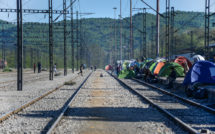

This is part of our special feature, Networks of Solidarity During Crisis.
This is part of our Campus Spotlight on Bennington College.
This class, which I taught as a small upper-level seminar, examined geographies of death, dying, and mourning as experienced by migrants living in diaspora or exile. As I describe in the syllabus, the course “mapped out the multiple mobilities of grief and death—the circulation of emotions, cadavers, toxins, and cancers, and mourning relatives gathering to grieve—and the political factors that co-produce death and mobility.” This course, as a human geography course informed by feminist theory and methods, aimed to help students understand “individual” grief as related to collective, large-scale trauma—as linked, multiscalar experiences—and to situate grief and death as political and unevenly distributed (rather than universal, as they are often framed).
On the first day of class, I opened with a provocation to the students. In the media, we are constantly inundated with images of grief, displacement, and death, from migrant crossings at the U.S. Mexico border to refugee crisis in the Mediterranean to bombings in Syria and Afghanistan. What do we do with these images and narratives? I asked. How are we to make sense of them? How do we process them when we have experienced them ourselves? Why study death at all? These would be the central questions animating our time together, I told them. But make no mistake: this course would be as much about life as it would be about death.
I then offered some orienting questions to lead the students into our work together, questions I would return to as anchor points several times over the semester:
- What is diaspora? What is displacement? How can we answer these questions using various disciplinary angles and forms?
- What are grief and mourning? What is death, and when, or why, or how is it political? How have people theorized these conditions or human experiences? What are the political structures of power, dominance, and violence that shape these experiences and their geographies?
- How does the act of migration—including going into exile, being displaced, and being separated from family—shape experiences of dying and mourning and loss?
- How do we research grief and grieving people ethically?
- How do we tell stories of grief, loss, and death? How do we do this across different media, disciplines, and audiences? What are different modes and media of narration that have been used, and to what effect?
We began the course with two weeks of reading and discussion on diaspora theory. The students’ first paper assignment prompted them to engage diaspora theories in order to answer the following questions: “Do diasporas disrupt the centrality of the nation-state in “powerful global histories,” politics, and culture? If so, how so? If not, why not? Does globalization replace nation-states with diasporas, or does it render diaspora theory obsolete? In other words, how are these geopolitical scales—the nation-state, diasporas, and the global—related to one another?” In their papers, students grappled with the varied, and at times contradictory, definitions of diaspora offered in the literature, tracing the concept’s evolution over nearly thirty years.
As we moved through the course, we considered Frantz Fanon’s writing on anticolonial melancholia and explored how exile appeared in the works of Palestinian poet Mahmoud Darwish and African American writer James Baldwin. In examining diasporas at various spatial and temporal scales, we took seriously geographer Caitríona Ní Laoire’s (2003: 279) point that “understanding diaspora practices and identities requires understanding their location in geographical, historical and material processes.” Repeatedly, we returned to Judith Butler’s question, “When is life grievable?” We engaged this question and others though a number of different methods, including life-mapping (Worth, 2011), feminist GIS and fear-mapping (Kwan, 2007), and ethnography (Mitchell-Eaton, 2019; Behar, 1997), as well as through film, documentary, fiction, memoir, poetry, and performance art. The syllabus was informed by feminist geopolitical scholarship on intimacy and geopolitics (Pain and Staeheli, 2014; Cowen and Story, 2016), as well as by indigenous theories on methods, trauma, and power (Tuck and Yang, 2014).
The course’s development was also informed by its student makeup. All but three of the seventeen students were international students or immigrant students, and many had experienced loss, longing, and displacement on multiple scales. They often brought these experiences into the classroom in highly personal and emotive ways. Conducting the course was a therefore a careful and collective process, one that required ongoing revision and reflection among the students and myself. In one particularly fraught session, for example, we discussed the film Who is Dayani Cristal?(2013), which retraces the journey of a Honduran migrant across the US-Mexico border after his body was discovered in the Arizona desert. The film, a sort of hybrid documentary-fictionalized narrative, was produced by Gael García Bernal and stars him as an undocumented migrant recreating the Honduran migrants’ trip. Several students, particularly Latinx and Latin American students, found the film frustrating: they felt it was gratuitous in its representation of migrant death and unethical in its protagonist’s disingenuous representation of himself (as migrant, rather than as actor) to others in the film. One Central American student knew people who had made that same perilous trip north across the border, and was angry that this story was now being commercialized for the titillation of U.S.-based viewers. Who was this film really for, they asked, and who benefits from telling these kinds of stories? Ultimately, we decided together that it was valuable to include the film in the syllabus, since it provoked a meaningful conversation about the ethics of representation and story-telling around death. But these conversations yielded no easy answers, and the stakes were not simply intellectual—they were deeply personal as well.
The students’ final presentations were outstanding in their creativity, rigor, and vulnerability. Students produced creative work across various genres and media including poetry, film, mental maps, family autoethnographies, and short film. Their projects addressed an extraordinary range of topics, including queer grief and José Esteban Muñoz’s “disidentifications,” Vietnamese and Armenian diasporas and narratives of homeland, memory in the aftermath of the Salvadoran civil war, themes of exile in James Baldwin’s Giovanni’s Room, Palestinian grief and displacement in music, themes of borders and landscape in Guillermo Galindo and Richard Misrach’s “Border Cantos,” a Día de los Muertosaltar for the victims of the Tamaulipas, Mexico massacre of 2010, emotional geographies of mourning, liminal/hybrid cultural identities theorized through the work of Stuart Hall and Gloria Anzaldúa, and much more.In reflecting upon this course and sharing this syllabus, I hope to prompt readers’ own reflections on pedagogical questions that I grappled with: What is an ethical, feminist pedagogy for teaching such emotionally loaded content? What sorts of course materials and topics require content warnings? What are humane ways of mapping and representing trauma? And, finally, how can we design and teach courses reflexively, in ways that center the multiple positionalities and embodied histories of the particular students that choose to take them?
Course Description
This class examines geographies of death, dying, and mourning as experienced by migrants living in diaspora or exile. We will map out the multiple mobilities of grief and death—the circulation of emotions, cadavers, toxins and cancers, and mourning relatives gathering to grieve—and the political, and imperial, factors that co-produce death and mobility—such as the U.S. nuclear testing in the Marshall Islands, or the woefully inadequate U.S. recovery efforts in Puerto Rico following Hurricane María. We will also consider the transnational political economy of dying ‘at a distance’—including the exorbitant costs of transporting bodily remains and the resulting shifts in migrants’ shifting burial and cremation practices—as well as affective circulations of grief and trauma across time and space. In particular, we will pay attention to how experiences of large-scale intergenerational trauma are compounded by and linked with experiences of ‘individual’ grief and loss by migrants living in diaspora. Throughout the course, we will engage feminist geopolitical scholarship on the interplay between the global and the intimate, as well as indigenous feminist theories on research methods, emotion, trauma, and power relations.
This course is designed around the principle of collective knowledge production, a key tenet of feminist thought and politics. Our aim is to create a space in which all members of the class are actively teaching and learning together, and to which we each bring our own intersectional positionality—our particular social location within broader matrices of power—as valuable feminist knowledge.
Required Texts
- Butler, Judith (2006). Precarious life: The powers of mourning and violence. Verso Press.
- Danticat, Edwidge (2007). The dew breaker. Vintage Press.
- Ondaatje, Michael (2011). Running in the Family. Vintage Canada.
- Online course reader (Google Drive)
The books can be purchased online or in the campus bookstore. I have also placed a copy of these texts on reserve at the library. You are responsible for bringing your readings to class each day in print.
Course Schedule
Below is the schedule of class readings and topics to be covered. Readings listed under each day are to have been completed by class that day.
I. INTRODUCTION TO CLASS
WEEK 1
September 5: Introduction to the Course
- No assigned readings
WEEK 2
September 9: Geographies of Grief, Mourning, Memory, and Politics: An Introduction
- Chowdhury, Elora Halim. 2007. “Geographies of mourning.” Frontiers: A Journal of Women Studies 28 (3): 113-140.
- Baptist, Karen Wilson. 2010. “Diaspora: Death without a landscape.” Mortality 15 (4): 294-307.
September 12: What is a Diaspora? Common Definitions and Populations of Study
- Cohen, Robin. “Four Phases of Diaspora Studies” (pgs. 1-19). Global diasporas: An introduction. Routledge, 2008.
- Mallipeddi, Ramesh. “A Fixed Melancholy”: Migration, Memory, and the Middle Passage.” The eighteenth century 55, no. 2 (2014): 235-253.
- Clifford, James. “Diasporas.” Cultural anthropology 9, no. 3 (1994): 302-338.
WEEK 3
September 16: What is a Diaspora?: Cultural Studies and Postcolonial Theory
- Hall, Stuart. “Cultural identity and diaspora.” In Diaspora and visual culture, pp. 35-47. Routledge, 2014.
- Brubaker, Rogers. “The ‘diaspora’ diaspora.” Ethnic and racial studies 28, no. 1 (2005): 1-19.
- Chariandy, David. “Postcolonial diasporas.” Postcolonial Text2, no. 1 (2005).
September 19: Mapping Movement: Diasporic Geographies
- Blunt, Alison. “Cultural geographies of migration: mobility, transnationality and diaspora.” Progress in human geography31, no. 5 (2007): 684-694.
- Ní Laoire, Caitríona. “Editorial introduction: locating geographies of diaspora.” International Journal of Population Geography 9, no. 4 (2003): 275-280.
In class: Library instruction session in Crossett (meet in regular classroom)
WEEK 4
September 23: The Geopolitics of Grief and Grievability
- Butler, Judith (2006). Pgs. xi-100. Precarious life: The powers of mourning and violence. Verso.
DUE: Paper #1: Theorizing Diaspora
September 26: Grievability and ‘Grief-Activism’
- Butler, Judith (2006). Selected chapters. Precarious life: The powers of mourning and violence. Verso.
- Stierl, M. (2016). Contestations in death–the role of grief in migration struggles. Citizenship Studies, 20(2), 173-191.
WEEK 5
September 30: Anticolonial Psychiatry and the Trauma of Occupation
- Fanon, Frantz (1963). Colonial Wars and Mental Disorders. In The Wretched of the Earth.
- Fink, Ann E. “Fanon’s police inspector.” AJOB neuroscience 10, no. 3 (2019): 137-144.
October 3: Migratory Grief, Cross-Cultural Loss, and the ‘Bereavement Exception’
- Casado, Banghwa Lee, Michin Hong, and Donna Harrington. “Measuring migratory grief and loss associated with the experience of immigration.” Research on Social Work Practice20, no. 6 (2010): 611-620.
- Wang, Kenneth T., Meifen Wei, Ran Zhao, Chih-Chun Chuang, and Feihan Li. “The Cross-Cultural Loss Scale: Development and psychometric evaluation.” Psychological assessment 27, no. 1 (2015): 42.
II. GEOGRAPHIES: THEORIZING GRIEF’S SPATIALITY
WEEK 6
October 7: Geographies of Scale: Intimacy-Geopolitics
- Pain, Rachel, and Lynn Staeheli. “Introduction: Intimacy‐geopolitics and violence.” Area 46, no. 4 (2014): 344-347.
- Cowen, Deborah, and Brett Story. “Intimacy and the everyday.” The Routledge Research Companion to Critical Geopolitics (2016): 341.
- Gray, Harriet. “The geopolitics of intimacy and the intimacies of geopolitics: combat deployment, post-traumatic stress disorder, and domestic abuse in the British military.” Feminist Studies 42, no. 1 (2016): 138-165.
DUE: Final project proposal
October 10: Cemeterial Politics: Memorialization, Memory, and Ruins
- Jorgensen‐Earp, Cheryl R., and Lanzilotti, Lori A. 1998. Public Memory and Private Grief: The Construction Of Shrines At The Sites Of Public Tragedy. Quarterly Journal of Speech, 84(2), 150-170.
- Christopher, Anthony J. “Segregation and cemeteries in Port Elizabeth, South Africa.” Geographical Journal (1995): 38-46.
- Miller, DeMond Shondell, and Jason David Rivera. “Hallowed ground, place, and culture: The cemetery and the creation of place.” space and culture 9, no. 4 (2006): 334-350.
- OPTIONAL READING: Trigg, Dylan. 2009. “The Place of Trauma: Memory, Hauntings, And the Temporality of Ruins.” Memory Studies, 2 (1): 87-101.
WEEK 7
October 14: Emotional Geographies and Affect
- Boccagni, Paolo, and Loretta Baldassar. “Emotions on the move: Mapping the emergent field of emotion and migration.” Emotion, Space and Society 16 (2015): 73-80.
- Pain, Rachel. “Globalized fear? Towards an emotional geopolitics.” Progress in Human Geography 33, no. 4 (2009): 466-486.
- Tolia‐Kelly, Divya P. 2006. “Affect–An Ethnocentric Encounter? Exploring the ‘Universalist’ Imperative of Emotional/Affectual Geographies.” Area, 38 (2): 213-217.
- Ahmed, Sara.”Affective economies.” Social text 22, no. 2 (2004): 117-139.
October 17: Life-Mapping: Geographies of Movements, Flows, and Stories
- Worth, Nancy. “Evaluating life maps as a versatile method for lifecourse geographies.” Area 43, no. 4 (2011): 405-412.
- Kwan, Mei-Po. “Affecting geospatial technologies: Toward a feminist politics of emotion.” The professional geographer 59, no. 1 (2007): 22-34.
- Caquard, Sébastien, and William Cartwright. “Narrative cartography: From mapping stories to the narrative of maps and mapping.” (2014): 101-106.
WEEK 8
October 21: Long Weekend: NO CLASS
October 24: Moving Away: Exile, Distance, and Identity
- Baldwin, James (1955). “Stranger in the village.” Notes of a native son. No. 39. Beacon Press.
- Chua, Charmaine. “The smell of wood.” Narrative Global Politics: Theory, History and the Personal in International Relations (2016): 159.
- Darwish, Mahmoud. “Exile is so strong within me, I may bring it to the land.” Journal of Palestine Studies 42 (2012): 1.
WEEK 9
October 28: Militarism, War, and Posthumous Citizenship
- Lee, Elizabeth, and Geraldine Pratt. “The spectacular and the mundane: Racialised state violence, Filipino migrant workers, and their families.” Environment and Planning A 44, no. 4 (2012): 889-904.
- Amaya, Hector. “Dying American or the violence of citizenship: Latinos in Iraq.” Latino Studies 5, no. 1 (2007): 3-24.
- Sohoni, Deenesh, and Amin Vafa. “The Fight to Be American: Military Naturalization and Asian Citizenship.” Asian Am. LJ 17 (2010): 119-151.
October 31: Plan Day (NO CLASS)
WEEK 10
November 4: Borders and Borderlands: ‘Una herida abierta’
- Anzaldúa, Gloria. Selected chapters. In Borderlands: La Frontera. Aunt Lute, 1987.
- Wright, Melissa W. “Necropolitics, narcopolitics, and femicide: Gendered violence on the Mexico-US border.” Signs: Journal of Women in Culture and Society 36, no. 3 (2011): 707-731.
DUE: Annotated bibliography
November 7: Screen Who is Dayani Cristal? (2013) in EAC 2
- Start Danticat, Edwidge (2007). The dew breaker. Vintage Press.
WEEK 11
November 11: Screen The Farewell (2019) in Tishman Auditorium
- Finish Danticat, Edwidge (2007). The dew breaker. Vintage Press.
November 14: Narrative and Representation: Story-Telling Grief in Novels, Film, and Photography
- Higbee, W., & Lim, S. H. (2010). Concepts of transnational cinema: towards a critical transnationalism in film studies. Transnational cinemas, 1(1).
- Azoulay, Ariella (2008). “A Comment on the Photograph” and Introduction (pgs. 7-28). The Civil Contract of Photography. New York: Zone Books.
WEEK 12
November 18: Climate Grief: Slow Violence, Accelerating Loss
- Nixon, Rob. Introduction (pgs. 1-44). Slow Violence and the Environmentalism of the Poor. Harvard University Press, 2011.
- Bonilla, Yarimar, & LeBrón, Marisol (eds.). (2019). Introduction and “The Trauma Doctrine.” Aftershocks of Disaster: Puerto Rico Before and After the Storm. Haymarket Books.
- Smith, Neil (2006). “There’s no such thing as a natural disaster.” SSRC. Retrieved online from: http://understandingkatrina.ssrc.org/Smith/
DUE: Film review
November 21: Nuclear Memory, Toxic Grief
- Boylan, Jessie (2019). “Grievability and Nuclear Memory.” American Quarterly 71(2): 379-388.
- Schwartz, Jessica A. “” Between death and life”: mobility, war, and Marshallese women’s songs of survival.” Women and Music: A Journal of Gender and Culture 16, no. 1 (2012): 23-56.
- Davies, T. (2013). A visual geography of Chernobyl: Double exposure. International Labor and Working-Class History, 84, 116-139.
- In class: View Chernobyl (2019) episode
- OPTIONAL READING: Gessen, Masha. What HBO’s “Chernobyl” Got Right, and What It Got Terribly Wrong. 4 June 2019. The New Yorker.
III. RESEARCH METHODS, ETHICS, AND REPRESENTATION
WEEK 13
November 25: Grief in the Field: Ethnographies of Mourning, Ethnographers Mourning
- Rosaldo, Renato. 2004. “Grief and a Headhunter’s Rage.” In Death, Mourning and Burial: A Cross Cultural Reader, ed. Antonius C. G. M. Robben, 167-78. Hoboken: Wiley-Blackwell.
- Behar, Ruth. 1997. Chapters 1, 5, & 6. The Vulnerable Observer: Anthropology that Breaks Your Heart. Boston: Beacon Press.
- Henry, Rosita. 2012. “Gifts of Grief: Performative Ethnography and the Revelatory Potential of Emotion.” Qualitative Research 12 (5): 528-539.
November 29: Thanksgiving break (NO CLASS)
- Start Ondaatje, Michael (2011). Running in the Family. Vintage Canada.
WEEK 14
December 2: Memoir: Death, Life, Memory
- Finish Ondaatje, Michael (2011). Running in the Family. Vintage Canada.
- In class: Peer workshop of final projects
December 5: The Ethics of ‘Mining’ Grief: Indigenous and Feminist Interventions
- Tuck, Eve, and K. Wayne Yang. “Unbecoming claims: Pedagogies of refusal in qualitative research.” Qualitative Inquiry 20, no. 6 (2014): 811-818.
- Mitchell-Eaton, Emily (2019). “Grief as method: Topographies of grief, care, and fieldwork from Northwest Arkansas to New York and the Marshall Islands.” Gender, Place & Culture 26 (10): 1438-1458.
- Pratt, Geraldine. 2009. “Circulating Sadness: Witnessing Filipina Mothers’ Stories of Family Separation.” Gender, Place & Culture 16 (1): 3-22.
- WEEK 15
December 9: Final presentations
December 12: Final presentations
Emily Mitchell-Eaton is a feminist geographer whose research focuses on the intersections of empire and migration. She holds a PhD in Geography from Syracuse University. Currently a Visiting Assistant Professor of Women’s, Gender, and Sexuality Studies at Williams College, she taught this course while at Bennington College in 2019.
Published on October 13, 2020.




